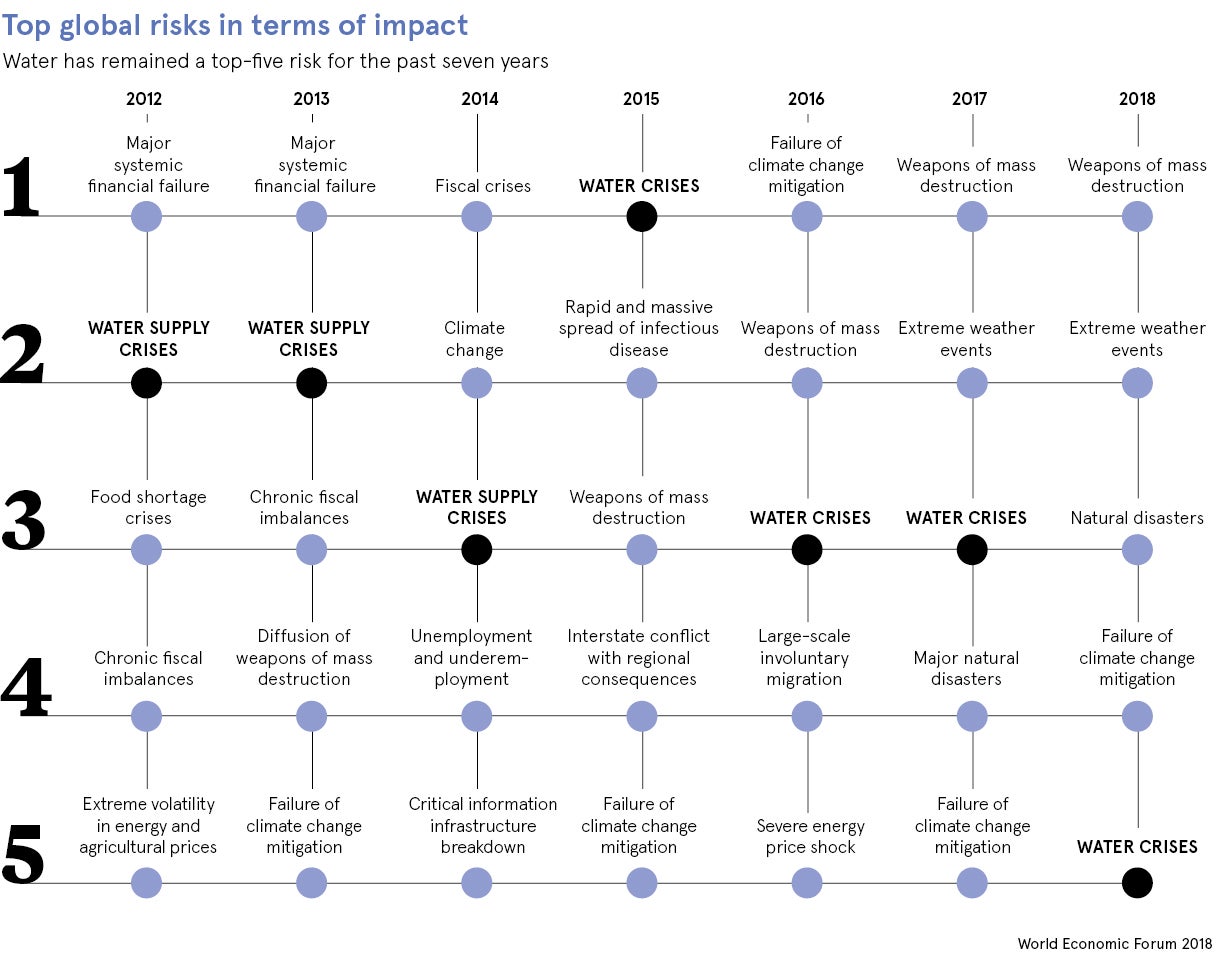Earlier this year, Cape Town came within a few drops of Day Zero when the taps are turned off. A serious drought was only just averted. This year, already the fourth hottest ever, is not a one off. Europe’s heatwave and drought have decimated crops, and could lead to spikes in food prices; California has been up in flames again, while Japan saw dozens of deaths from sweltering heat.
“This is the new norm,” explains Alex Mung, head of Water Initiative at the World Economic Forum (WEF). “We’re seeing the impacts of drought and abnormally hot temperatures around the world. We have seen such scenarios before in São Paulo and this year in Sydney where water reached record lows, raising urgent questions about the security of the city’s water supply.”
Water has ranked in the top five risks for seven consecutive years in the World Economic Forum’s Global Risk Report. And if you look at the headline threats to humanity and the planet over the next decade, as pinpointed by 1,000 experts, all but one are linked to water. These include extreme weather, natural and man-made disasters, climate change, biodiversity loss and ecosystem collapse.
These events destroy lives and livelihoods, and water is at the heart of the issue.
Greater value needs to be placed on water
“Water insecurity will continue to cause ripple effects across global supply chains from manufacturing to agriculture, it will strain geopolitical ties and it will place untold pressure on the world’s poorest populations,” warns Mr Mung. “The resilience of our society, both in terms of economic growth and human security, must be addressed through a water lens.”
While other global risks have peaked and subsided, water has stubbornly remained. It is the ultimate public goods challenge, complex and inter-connected across many aspects of society.
Tackling the issue requires collaborative, cross-sector solutions and a shift by all stakeholders to place a higher value on water.
“Let’s face it, water is chronically undervalued and, in some cases, not valued at all. Only by embedding its true financial, social and environmental value into policymaking, governance, and financial and risk reporting can we instil a better mentality,” says Mr Mung. “Take wastewater treatment and reuse: when water is valued properly, there are incentives to fully capture the benefits of a circular economy which can bring about a range of new innovations.”
Using tech and data to prepare for water challenges
It is widely agreed that a business-as-usual approach cannot address global water challenges in the future, nor will our current strategies sustain the world’s thirst much longer, particularly when the population hits eight, nine or ten billion in the coming decades. Yet cold, hard data on how our water systems function is still lacking.
“A key challenge is obtaining and accessing a complete, up-to-date picture of supply and demand to understand competing needs and trade-offs. Too often, issues of data access, fragmentation and quality constrain decision-makers,” explains Mr Mung.
Technology such as satellite imagery and other Earth observation tools can help. In 2021, the Surface Water Ocean Topography mission, a joint satellite mission between Nasa and France, will use radar technology to provide the first global survey of Earth’s water, measuring how bodies of water change over time. The satellite will survey at least 90 per cent of the planet, studying lakes, rivers, reservoirs and oceans roughly twice every 21 days.
How technology is countering water challenges in agriculture
In the agriculture sector, companies such as Microsoft are demonstrating how precision irrigation using smart sensors in fields can give information about soil conditions. Crop data, coupled with drone images of fields, and the use of artificial intelligence to interpret data and model a heat map of the crop area, can all help ensure water is used optimally in food production.
“Emerging fourth industrial revolution technologies – machine-learning, artificial intelligence, advanced sensors, satellite imagery, robotics and others – have the potential to unlock a wealth of previously unobtainable data about water systems at the global, regional, watershed and local level,” says Mr Mung.
“Combined with new forms of public-private collaboration, these technologies can support decision-makers across industry, government and civil society to balance trade-offs, identify common priorities and make smarter investment choices.”
Emerging fourth industrial revolution technologies have the potential to unlock a wealth of previously unobtainable data about water systems
Governments must aid development of water technologies
The WEF believes leveraging emerging water technologies into the mainstream cannot be left to startups, accelerators and investors alone. New research is also desperately needed to explore the implications of emerging tech in areas ranging from ecosystem management to sanitation and water risk disclosure.
“Governments must remain at the centre of the water innovation agenda. They are ultimately responsible for ensuring technologies are developed responsibly. Public authorities will also need to develop new policy frameworks for how emerging technologies are tested and refined,” says Mr Mung.
Any killer water app will also need to be scaled up, derisked and endorsed at all levels. “Building a strong culture of innovation is critical for the global water community’s ability to fully harness the fourth industrial revolution. Without this, technology-enabled solutions will still be developed, but likely by a select few and not necessarily in a way that gets to the root of water challenges,” he says.
Greater value needs to be placed on water


